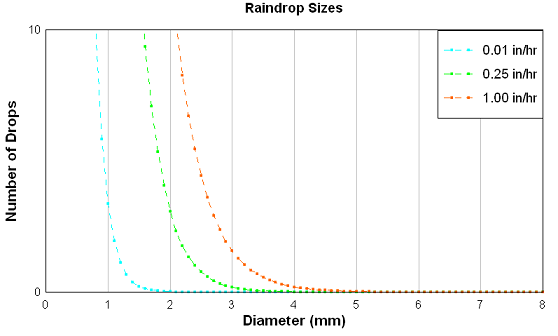Raindrops
So, it’s not raining today. But, it should be raining again later this week, and it rained last week, so maybe things will be getting better with the drought over the next month or two. I think they will.
I posted a 1/60 speed picture of the raindrops in last Wednesday night’s storm https://www.jamesspann.com/wordpress/?p=4278. But, when rain is heavier, are the drops bigger? Are there more of them? Do they fall faster? We’re looking at some of that at UAH, since it is important in radar meteorology and rainfall estimation.
Raindrops are changing in size as they fall. Sometimes, two or more rain drops will coalesce into one larger drop, other times a raindrop becomes too big and breaks up. But, in general, Marshall and Palmer (1948) found that, no matter how heavy the rain, there are usually more raindrops that are smaller in size, and less raindrops at larger sizes. The raindrops follow an “exponential distribution” (ask my wife, the actuary, more about this), ie., there a lot more small raindrops than medium-sized drops, and even less large drops. The Marshall-Palmer distribution for different rainfall intensities is graphed below.


(These charts show the number of raindrops in a cubic meter of air, or roughly a cubic yard). Even for heavy rain (1 in/hr), most of the drops are less than 1 mm in diameter. For drizzle (0.01 in/hr), roughly 81% of the drops are less than 0.25 mm across. Light-moderate rain is in between. Notice in the lower chart, zoomed in at the largest drops, that there are a few drops larger than 4 mm across in heavy rain. Also, summing all the drop sizes, there are about 1500 drops/m3 in the drizzle, 2900 in the light-moderate rain, and 3800 in the heavy rain. Heavy rain has more drops and bigger drops, in a given volume of air.
Even though most of the drops are small, the bigger ones contain a lot more water, since the volume varies roughly as r^3. The chart below shows for heavy rain, even though most of the drops are small (less than 0.5 mm in diameter), most of the water content is in the drops 1 to 2 mm in diameter.
Another factor here is the fallspeed. Air resistance holds the drops back, yet raindrops (especially big ones) are flattened some by the air resistance (see picture below, from Choji Magono, in Battan 1962). The net result is that bigger ones fall faster. A 0.3 mm raindrop falls at only 2.7 mph, but a bigger, 5 mm raindrop (rare because it may break up due to its size) falls at 20 mph! These are the ones that hit the windshield loudly, especially at the beginning of a thunderstorm.
Factoring in the raindrop sizes and fallspeeds, the following chart shows how much of a 1 inch per hour rain is due to each range of drop sizes.
Even though only about 1.4% of the raindrops are in the 2-3 mm range, they account for more than 0.3″ of the 1.0″ of rain per hour in a heavy rain.
So, in summary, in a a heavy rain there are more drops, some of the drops are bigger and fall faster, and the bigger drops are where most of the rain that accumulates comes from. 10 minutes of heavy rain can give you more rain than a whole day of very light rain!
More on UAH research on drop-sizes and radar later.
Category: Uncategorized
















Comments (1)
Trackback URL | Comments RSS Feed
Sites That Link to this Post